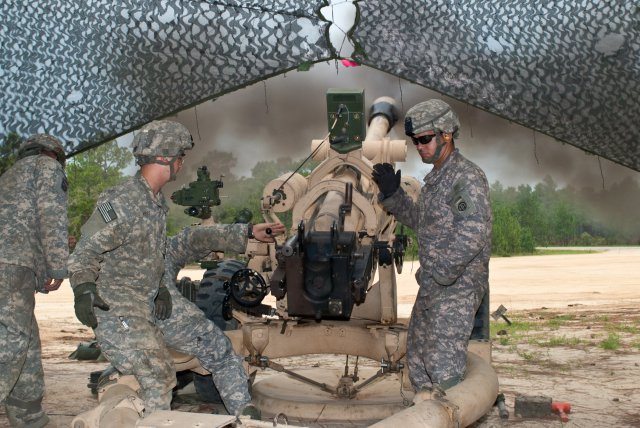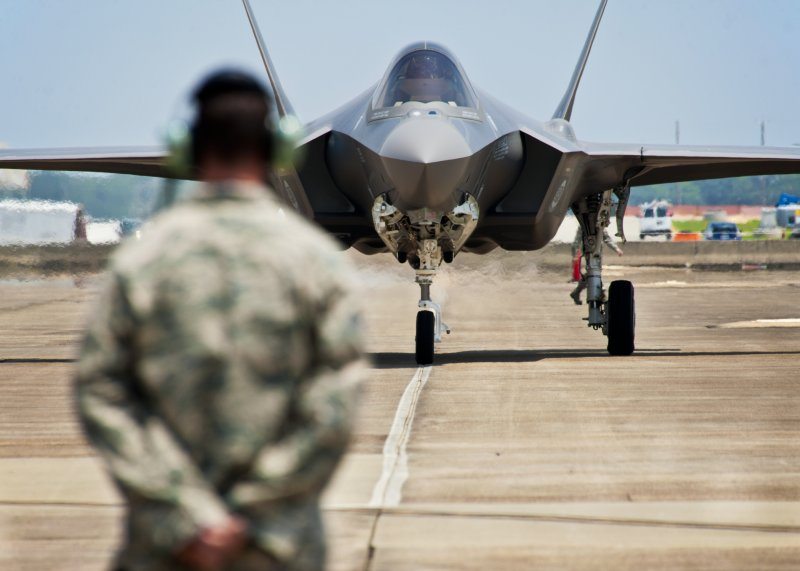Paratroopers here stepped up back-to-basics training with a 10-day brigade-sized field exercise during one of the hottest weeks of one of the hottest summers on record.
Over three thousand paratroopers with the 82nd Airborne Division’s 1st Brigade Combat Team removed themselves from garrison life to focus on basic skills critical to accomplishing the missions they might be assigned, said brigade commander, Col. Mark L. Stock.
For the brigade staff, the field training exercise, or FTX, was an opportunity to build their systems, test their tools and to discover how their time and resources can be best used to accomplish the mission, said Stock.
“Everybody fights. Ask yourselves, ‘What needs to be done?’” Stock said to his staff.
While there were a number of heat-related injuries, particularly early on in the exercise, brigade and battalion leaders modified the training times and operational tempo to reduce the risk while still offering challenging training.
“The conditions are realistic,” said Maj. Jason Condrey, operations officer for 2nd Battalion, 504th Parachute Infantry Regiment, one of 1BCT’s two infantry battalions. Fresh from the second of two tours to Afghanistan, Condrey added, “As far as leadership lessons, we need to learn when we should and should not do operations and how we should do them when the environment is as fierce as it is here and some portions of Afghanistan. The fact that it’s hot doesn’t mean we don’t have a job to do. We have to learn how to operate.”
Within the brigade’s six battalions, training focused on platoon-level “collective” skills that built upon the individual, team and squad-level training accomplished earlier in the year, according to Maj. Mark Stouffer, officer in charge of brigade operations.
Stouffer, who began his Army career as a lieutenant with the 82nd in 1996 and went on to serve with the Rangers and other units within the special-operations community, said that he was proud of the hard work going on both physically and mentally under brutally hot conditions.
For infantry platoons with 2-504th PIR, the training included rotations through a strenuous 72-hour field problem during which they were graded by external evaluators.
The field problem included movement to contact, a key-leader engagement, ambush, setting up a defensive position and a live-fire range, peppered with smaller tasks along the way that might include reacting to mortar attack or roadside bomb, or calling in air support or Medevac helicopter.
“When designing the training lanes, we went back to the basics,” said Lt. Col. Praxitelis “Nick” Vamvakias, 2-504 battalion commander.
“A lot of guys had deployed experience, but not so much in a field environment outside of [fortified U.S. bases] and doing mounted and dismounted patrolling from those locations,” Vamvakias said. “So we went back to the basics of fire and maneuver with movement to contact and defense so that everyone learned the principles and priorities of work in both.”
“Then, platoon attack,” he added. “We are an offensive Army. Platoon attack is a critical, essential task for a platoon to execute.”
Lessons learned by the infantrymen included over-communicating one’s piece of the action; being precise and accurate when reporting enemy movement, position and numbers; using speed as a form of security; never look away from where one’s muzzle is pointed; in a building, not forgetting the fight outside; how to use enablers such as scouts once they have joined the team; preventing fratricide when clearing buildings; remembering the old adage that that “slow is smooth, and smooth is fast.”
These fundamental skills were evaluated in addition to counterinsurgency operations such as the key-leader engagements and reacting to roadside bombs, tasks more common in today’s asymmetrical warfare in Iraq and Afghanistan, said Vamvakias.
Vamvakias, who began his Army career in the 82nd as a platoon leader with 1st Battalion, 504th PIR, said that, in spite of the greater aggregate of skills required of today’s troops, they are wholly capable of rising to the challenge.
“They are American soldiers,” he said. “They are very capable, flexible and adaptable individuals. Pushing everybody to their limits is what helps them realize they can do more.
“When I was a platoon leader, my brigade commander, now retired Gen. John Abizaid, was asked whether we should have a peace-keeping and a combat army or just a combat army. His answer was, ‘If you are an expert at the basics, you can do anything.’ He dealt with counterinsurgency and irregular warfare before it was commonplace. I go back to that statement to remind us of the importance of the basics.”
Training lanes for the brigade’s reconnaissance battalion, 3rd Squadron, 73rd Cavalry Regiment, included many of the same challenges posed to the infantry, but with added cavalry-specific tasks such as route reconnaissance and tactical mounted gunnery.
“We have to fight as infantry for the first 24 hours, and then we have to do the reconnaissance fight for our boss immediately following the assault,” said Lt. Col. Mark Dotson, squadron commander.
As with much of the brigade, 3-73 CAV lost many of its noncommissioned officers a year ago following its return from Iraq. Training exercises like this FTX are critical to rebuilding noncommissioned officer, or NCO, strength, said Dotson.
“The NCOs we have coming in are more mechanized or Stryker oriented,” he said. “We are having to retrain those guys as well as our new privates as they come in.”
Dotson said the benefit of having that cross section of NCOs with varied experiences is that, once they do figure out how to make the platoons work, they often bring fresh and sometimes better ideas to the table.
The brigade’s artillery support, 3rd Battalion, 319th Airborne Field Artillery Regiment, was somewhat ahead of the rest of the battalions with battalion-level operations. In a nod to the back-to-basics framework, they enlisted the aid of combat engineers to construct a dug-in firebase with concealed artillery positions, a perimeter of earthworks, concertina wire and gun positions and round-the-clock guards.
Support troops, including the truckers, fuelers, cooks and medics of 307th Brigade Support Battalion, and the engineers, communications and intelligence specialists, and military police of 1st Brigade Special Troops Battalion conducted their own platoon evaluations while supporting the various battalions as they would in combat.
Since the Army modularized its forces in 2004-05 and brigade combat teams became self-sustaining units with their own organic combat enablers, brigade FTXs are rich opportunities for combat and support troops to train together and learn from each other, agreed Vamvakias and Dotson.
“Now it is very easy for us during our squad live-fire portion to integrate fires from 3-319th, and they are able to support us very easily,” explained Dotson. “On the route reconnaissance and mounted gunnery ranges, we had engineers from 1BSTB. Ten years ago you would not see these things as part of a platoon ex-eval because it would be so hard to coordinate. Now it’s just a matter of course.”
The FTX also allowed the entire brigade staff to exercise their systems in the field, practice their standard operating procedures, test connectivity with the battalions, and work through growing pains, said Stouffer, the brigade operations officer.
“Our progress over last six to eight months has been very good, but there’s always room for improvement,” he said. “I believe that’s our job as leaders and as Soldiers. The training path ahead of us will definitely get us to where we need to be prior to a deployment.”
That type of progress in a complex training environment is typical of paratroopers, said Command Sgt. Maj. Scott Brzak, the senior enlisted adviser with 2-504. Though Brzak began his career with the light-infantry 10th Mountain Division, he has since served with every airborne unit in the Army outside of a Ranger Regiment.
“The 82nd has a long, proud history of having quality NCOs and leaders, and they seem to draw the best from throughout the army to come here, share their knowledge, training, and discipline in the organization,” said Brzak, who attributes many of those same qualities to the airborne community at large.
“We infuse changing demands into our training, so that when we get the call to go do something we weren’t planning on doing or receive a change of mission, it’s no big deal,” he said.
The time involved in setup and tear-down required paratroopers to spend two weeks and a weekend away from family, a precious commodity for regularly-deploying troops.
“Taking care of our paratroopers and our families is key,” said Vamvakias. “To take care of our paratroopers in combat, we’ve got to spend quality time training in the field, and that means time away from families. That comes sometimes at the cost of weekends. At the same time, we try to balance that out with additional days off and comp days for the days they were gone in the field.”
Returning from Afghanistan a month ago, his new operations officer, Condrey, agreed.
“You do your job and teach and let those lessons you’ve learned with blood be lessons learned with sweat out here on the training range. That’s what this is all about,” he said.
The 82nd Airborne Division’s 2nd Brigade Combat Team is currently deployed in al Anbar Province, Iraq, where 1BCT served as an advise-and-assist brigade in a 2009-10 deployment. 3BCT is currently serving as the ground component of the nation’s stand-by emergency Global Response Force, and 4BCT and the Combat Aviation Brigade are slated to deploy to Afghanistan later this fall. The division headquarters is deploying to Afghanistan this month.
1BCT is awaiting orders.











